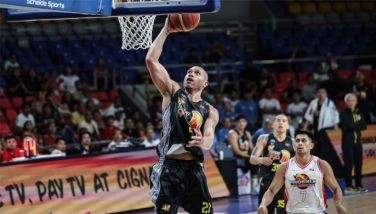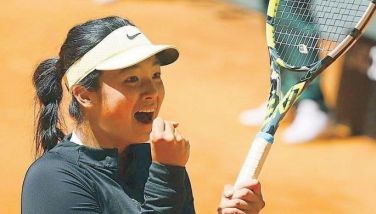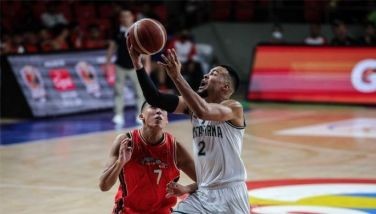US cagers lose their shirts

In the 1936 Berlin Olympics, the Philippine national basketball team known as the Islanders took fifth place despite losing only to eventual gold medalist US and winding up with a 4-1 record. It remains the highest finish ever by an Asian team in Olympic basketball and a tribute to coach Chito Calvo, the only Filipino enshrined in the FIBA Hall of Fame and recently named to the fourth batch of Sports Hall of Famers by the PSC.
There were 23 teams listed in the inaugural Olympic basketball competition but Spain and Hungary withdrew before the games began. Another country Peru backed out in the quarterfinals after beating Egypt, 35-22 and China, 29-21 in the elimination stage. Peru’s entire Olympic delegation left Berlin to protest a ruling to replay the football team’s 4-2 overtime win over Austria.
The Philippines drew a bye in the first round then came back from a two-point halftime deficit to stun Mexico, 32-30 in the second round. Calvo’s squad advanced to the 14-team pre-quarterfinals and beat European champion Estonia, 39-22. In the knockout quarterfinals, the Philippines bowed to the US, 56-23 but the Islanders bounced back to crush Italy, 32-14 and Uruguay, 33-23, in the classifications for fifth spot. The US took the gold, Canada the silver and Mexico the bronze. Ironically, the Philippines lost only once and placed fifth while Mexico was beaten twice, once by the Islanders, but landed a podium finish.
Believe it or not, the Philippines could’ve been undefeated in the tournament if only the US was penalized by default for showing up with no uniforms. Apparently, the US red-white-and-blue Spalding jerseys were nowhere to be found in the dressing room before the game. The shorts were in the dugout but the shirts were missing. “The boys improvise and enter the game with wrinkled T-shirts, looking and feeling like a rag-tag team,” wrote Beth Fortenberry in the book “Slam Dunk: The True Story of Basketball’s First Olympic Gold Medal Team.” “Despite the outfits, the team plays cool, calm and collected 1-on-1 basketball, forcing the Filipinos to run hard.” The US led, 28-20, at the half then limited the Philippines to only three points the rest of the way. “It’s fire-alarm, harem-scarem, zone press at its finest,” continued Fortenberry whose father Joe played for the US. “The Filipinos are so intimidated that they add only three points.”
Andrew Maraniss, in his book “Games of Deception,” said “though the Filipinos were at a significant height disadvantage, they gave the Americans a terrific battle in the first half ... scribbling in his notebook, (James) Naismith remarked that if not for the size differential, the crowd-favorite, underdog Philippine team might have won the game.” Naismith, who invented basketball in 1891, was in the audience.
Surely, the wrong jerseys weren’t the only reason why the Philippines could’ve won. Before the competition, the rule was players could only be up to 6-2 (some sources claimed 6-3). The US, however, complained and threatened to boycott the competition. Officials gave in and allowed the US to enlist four players over 6-2 – 6-3 Ralph Bishop, 6-8 Fortenberry, 6-7 Frank Lubin and 6-8 Willard Schmidt. The Philippines’ tallest player was 6-1 Charlie Borck and everyone else was less than six feet with Jacinto Ciria Cruz the shortest at 5-7. Other rules were no three-second violation, no shot clock, a jumpball after every basket, no player could reenter the game from a substitution except in case of an injury or disqualification by fouls, no limit to cross the midcourt line, two 20-minute halves and only seven to play. The ball had no grain so the leather surface was smooth and slippery, was slightly oversized and laced on one side. Each team was allowed to list a 14-man lineup and eight teams did, including the US, China and Germany. Aside from China and the Philippines, the only other Asian country to participate was Japan.
The Philippines had a 12-man roster but Calvo rotated only nine to play seven in a game. The players were Borck, Ambrosio Padilla, Primitivo Martinez, Jess Marzan, Amador Obordo, Cruz, Franco Marquicias, Bibiano Ouano, Fortunato Yambao, Antonio Carillo, Miguel Pardo and John Worrell. The games were played in an outdoor tennis plaza with four of the 12 courts modified for basketball on red clay mixed with sand and silt to provide a harder surface. Maraniss wrote that “one row of wooden bleachers lined the courts, providing seating for 112 dignitaries and media and behind that there was standing room for another 700 spectators.” In Sunday’s column, we’ll uncover the life of coach Chito Calvo.
- Latest
- Trending































